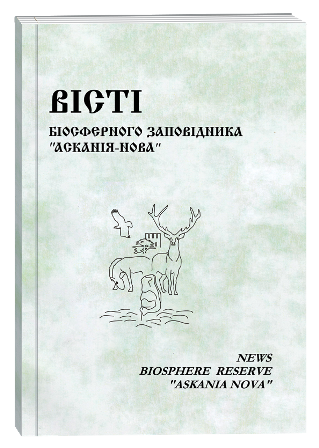MORPHOMETRIC PARAMETERS AND ANTIOXIDANT POTENTIAL OF FRUITS OF MEDLAR TREE MESPILUS GERMANICA L.
DOI:
https://doi.org/10.53904/1682-2374/2019-21/46Abstract
The aim of this study was to determine morphometric parameters and biological activity of fruits of perspective genotypes of medlar (Mespilus germanica L.) from a collection of M.M. Gryshko National Botanical Garden of NAS of Ukraine. Genotypes differed by weight, shape, and size of fruits. The average weight of fruit was from 27.60 to 39.12 g, height from 34.20 to 42.29 mm, diameter from 36.31 to 44.75 mm. Index of fruit shape was determined in range from 0.65 to 1.28. The most variable features are the diameter of calyx basin (27.96 %) and weight of fruit (21.69 %), which are important parameters for selection that indicates about perspectivity of selection. Antioxidant activity by DPPH-method (0.89–2.09 mg TE/g) and phosphomolybdenum method (54.16–99.86 mg TE/g) demonstrates strong positive correlation with total content of polyphenols (4.17–9.39 mg GAE/g) in the fruit extracts. Obtained results demonstrate that fruits of medlar tree, cultivated in Ukraine, are a valuable source of polyphenol compounds with high antioxidant activity.
References
Akbulut M., Ercisli S., Jurikova T., Mlcek J., Gozlekci S. Phenotypic and bioactive diversity on medlar fruits (Mespilus germanica L.). Erwerbs-Obstbau. 2016. Vol. 3. P. 185–191.
Ayaz F. A., Huang, H. S., Chuang, L. T., Vanderjagt, D. J., Glew, R. H. Fatty acid composition of medlar (Mespilus germanica L.) fruit at different stages of development. Italian Journal of Food Science. 2002. Vol. 14. P. 439–446.
Ayaz F. A., Demir O., Torun H., Kolcuoglu Y., Colak A. Characterization of polyphenoloxidase (PPO) and total phenolic contents in medlar (Mespilus germanica L.) fruit during ripening and over ripening. Food Chem. 2008. Vol. 106. Р. 291–298.
Aygun A., Tasci A. R. Some fruit characteristics of medlar (Mespilus germanica L.) genotypes grown in Ordu, Turkey. Sci Pap Ser B Hortic. 2013. Vol. 57. P. 149–152.
Baird R., Thieret J. W. The medlar (Mespilus germanica, Rosaceae) from antiquity to obscurity. Economic Botany. 1989. Vol. 43. Р. 328372.
Brindza P., Brindza J., Tóth D. Klimenko S. V., Grigorieva O. Slovakian cornelian cherry (Cornus mas L.): potential for cultivation. Acta Hortic. 2007. Vol. 760. P. 433–437.
Brindza J., Grygorieva O., Klymenko S., Vergun O., Mareček, J., Ivanišová, E. Variation of fruits morphometric parameters and bioactive compounds of Asimina triloba (L.) Dunal germplasm collection. Potravinarstvo Slovak Journal of Food Sciences. 2019. Vol. 13. P. 1–7.
Clarke K., Gorley R. PRIMER v6: User Manual/Tutorial. Plymouth, UK: Primer-E, Ltd., 2006. 192 p.
Ercisli S., Sengul M., Yildiz H., Sener D., Duralija B., Voca S., Purgar D. D. Phytochemical and antioxidant characteristics of medlar fruits (Mespilus germanica L.). Journal of Applied Botany and Food Quality. 2012. Vol. 85. P. 86–90.
Glew R. H., Ayaz F. A, Sanz C., VanderJagt D. J., Huang H. S., Chuang L. T., Strnad M. Changes in sugars, organic acids and amino acids in medlar (Mespilus germanica L.) during fruit development. Food Chem. 2003a. Vol. 83. Р. 363–369.
Glew, R. H., Ayaz, F. A., Sanz, C., VanderJagt, D. J., Huang, H. S., Chuang, L. T., Strnad, M. Effect of postharvest period on sugars, organic acids and fatty acids composition in commercially sold medlar (Mespilus germanica "Dutch") fruit. Eur Food Res Technol. 2003b. Vol. 216. P. 390–394.
Gruz J., Ayaz F. A., Torun H., Strand M. Phenolic acid content and radical scavenging activity of extracts from medlar (Mespilus germanica L.) fruit at different stages of ripening. Food Chem. 2011. Vol. 124. P. 271–277.
Grygorieva O., Klymenko S., Brindza J., Kochanova Z., Toth D., Derevjanko V., Grabovecka O. Introduction, breeding and use of persimmon species (Diospyros spp.) in Ukraine. Acta Hort. 2009. Vol. 833. P. 57–62.
Grygorieva O., Abrahamová V., Karnatovská M., Bleha R., Brindza J. Morphological characteristic of fruit, drupes and seeds genotypes of Ziziphus jujuba Mill. Potravinarstvo Slovak Journal of Food Sciences. 2014. Vol. 8. P. 306–314.
Grygorieva O., Klymenko S., Horčinová Sedláčková V., Šimková J., Brindza J. Phenological growth stages of chinese quince (Pseudocydonia sinensis C.K. Schneid.): codification and description according to the BBCH scale. Agrobiodiversity for improving nutrition, health and life quality. 2018. Vol. 2. P. 292–299.
Gülçin L., Topal F., Sarıkaya B. Ö., Bursal E., Bilsel G., Gören A. C. Polyphenol contents and antioxidant properties of medlar (Mespilus germanica L.). Rec. Nat. Prod. 2011. Vol. 5, Vol. 3. Р. 158–175.
Haciseferogullari H., Ozcan M., Sonmete M. H., Ozbek O. Some physical and chemical parameters of wild medlar (Mespilus germanica L.) fruit grown in Turkey. Journal of Food Engineering. 2005. Vol. 69. P. 1–7.
Horčinová Sedláčková V., Grygorieva O., Fatrcová-Šramková K., Vergun O., Vinogradova Y., Ivanišová E., Brindza J. The morphological and antioxidant characteristics of inflorescences within wild-growing genotypes of elderberry (Sambucus nigra L.). Potravinarstvo Slovak Journal of Food Sciences. 2018а. Vol. 12. P. 444–453.
Horčinová Sedláčková V., Grygorieva O., Brindza, J. Morphometric characteristic of wild-growing genotypes of elderberry (Sambucus nigra L.) with dark and green fruits. Agrobiodiversity for Improving Nutrition, Health and Life Quality. 2018b. Vol. 2. P. 250–261.
Ivanišová E., Grygorieva O., Abrahamová V., Schubertova Z., Terentjeva M., Brindza J. Characterization of morphological parameters and biological activity of jujube fruit (Ziziphus jujuba Mill.). Journal of Berry Research. 2017. Vol. 7. P. 249–260.
Klimenko S. The cornelian cherry (Cornus mas L.): collection, preservation and utilization of genetic resources. J. Fruit Ornam. Plant Res. 2004. Vol. 12. P. 93–98.
Klymenko S., Grygorieva O., Onyshuk L. Biological bases of seed and vegetative reproduction of cornelian cherry (Cornus mas L.) in nature and culture. Agrobiodiversity for improving nutrition, health and life quality. 2017. Vol. 1. P. 233–248.
Klymenko, S., Grygorieva, O., Brindza, J. Less Known Species of Fruit Crops. Slovak University of Agriculture in Nitra, 2017. 104 p.
Kucelova L., Grygorieva O., Ivanišová E., Terentjeva M., Brindza J. Biological properties of black mulberry-derived food products (Morus nigra L.). Journal of Berry Research. 2016. Vol. 6. P. 333–343.
Miko M., Gažo J. Biologické vlastnosti a hodnotenie genofondu mišpule obyčajnej (Mespilus germanica L.). Nitra : Slovenská poľnohospodárska univerzita, 2014. 97 s.
Monka A., Grygorieva O., Chlebo P., Brindza J. Morphological and antioxidant characteristics of quince (Cydonia oblonga Mill.) and chinese quince fruit (Pseudocydonia sinensis Schneid). Potravinarstvo Slovak Journal of Food Sciences. 2014. Vol. 8. P. 333–340.
Nabavi S. F., Nabavi S. М., Ebrahimzadeh M. А., Asgarirad Н. The antioxidant activity of wild medlar (Mespilus germanica L.) fruit, stem bark and leaf. African Journal of Biotechnology. 2011. Vol. 10. P. 283–28.
Nezhadghan B., Hassanpou H. Investigation of physicochemical characterizations of some Medlar (Mespilus germanica L.) genotypes in East Azerbaijan province. Iranian Journal of Horticultural Science. 2018. Vol. 49. P. 157–169.
Pourmortazavia S. M., Ghadirib M., Hajimirsadegh S. S. Supercritical fluid extraction of volatile components from Bunium persicum Boiss. (Black cumin) and Mespilus germanica L. (medlar) seeds. J. Food Comp. Anal. 2005. Vol. 18. Р. 439–446.
Prieto P., Pinera M., Aguilar M. Spectrophotometric quantitation of antioxidant capacity through the formation of a phosphomolybdenum complex: Specific application to the determination of vitamin E. Analytical Biochemistry. 1999. Vol. 269. P. 334–337.
Rop O., Sochor J., Jurikova T., Zitka O., Skutkova H., Mlcek J., Salas P., Krska B., Babula P., Adam V., Kramarova D., Beklova M., Provaznik I., Kizek R. Effect of Five Different stages of ripening on chemical compounds in medlar (Mespilus germanica L.). Molecules. 2011. Vol. 16. P. 74–91.
Sanches-Moreno C., Larrauri A., Saura-Calixto F. A procedure to measure the antioxidant efficiency of polyphenols. Journal of Sciences and Food Agricultural. 1998. Vol. 76. P. 270–276.
Singleton V. L., Rossi J. A. Colorimetry of total phenolics with phosphomolybdic-phosphotungstic acid reagents. American Journal of Enology and Agricultural. 1965. Vol. 6. P. 144–158.
Stehlíková B. Basics of biostatiscics (Biodiversity protection 51). Nitra: SPU, 1998. 79 p.
Sulusoglu M., Unver H. Morphological and chemical properties of medlar (Mespilus germanica L.) fruits and changes in quality during ripening. AGROFOR International Journal. 2016. Vol. 1. Р. 133–140.
Vinogradova Yu., Grygorieva O., Vergun O., Brindza J. Morphological characteristics for fruits of Aronia mitschurinii A. K. Skvortsov & Maitul. Potravinarstvo Slovak Journal of Food Sciences. 2017. Vol. 11. P. 754–760.
Yilmaz A., Gerçekcioğlu R., Özatasever Ö. Determination of pomological and chemical properties of some medlar (Mespilus germanica L.) genotypes. Journal of New Results in Science. 2016. Vol. 5. P. 118–124.







